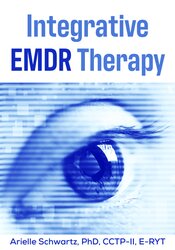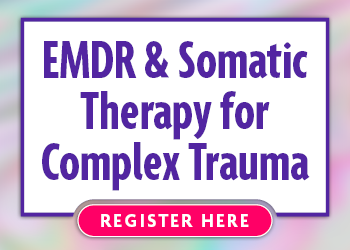EMDR and somatic therapy complement one another well. Somatic therapy techniques and exercises work directly with the body and nervous system to release stored emotions, trauma, and pain. Simultaneously, EMDR helps to reprocess traumatic memories freeing the mind from repetitive thoughts, overwhelming emotions, and more. Incorporating somatic techniques into EMDR gives you tools to help your clients stay grounded, even during the most intense parts of trauma processing. Additionally, it helps to support clients being more introspective, improving their awareness and insight during treatment.
This is your chance to make working with trauma feel simpler and more impactful than ever before…
…by skillfully using 2 of today's most trusted therapies to treat trauma in the body and the mind.
You'll join our team of expert trainers as they provide you with a step-by-step treatment roadmap that shows you exactly how to target your clients' bodily sensations and emotions with somatic techniques…
…all while safely and gently processing traumatic memories with EMDR therapy.
When you register, you'll get instant access to on-demand training that will make using an EMDR and somatic therapy approach easy to learn and apply, including:
- EMDR instruction with certified EMDR trainer, Karee Powers
- Key somatic therapy skill building with a world-leading somatic therapy expert, Abi Blakeslee, PhD
- Step-by-step instruction for integrating somatic and parts work with Dr. Sandra Paulsen
From keeping clients within their window of tolerance to grounding them in their bodies for safe, gentle, and empowering healing experiences…
…you'll get dozens of tools you can use right away, even if you've never used either of these approaches before.
We're confident this course will add new dimensions of depth to your treatment you won't find anywhere else.
Don't miss this opportunity to transform your approach to trauma therapy—secure your spot today!
EMDR & Somatic Therapy Integration
$1,299.96 Value — Only $299.99
Click here for Credit details | Click here for course objectives and outline
This product is not endorsed by, sponsored by, or affiliated with the IFS Institute and does not qualify for IFS Institute credits or certification.
PLUS… Bonus training on modified EMDR therapy with leading traumatologist Arielle Schwartz! This $129.99 FREE CE training teaches you...
Master:
- Specific tools to overcome dissociation and fragmentation
- How to "unburden" and release pain from wounds of the past
- Strategies to decrease defensiveness that are rooted in compassion and mindfulness
- A deeper understanding of development and sociocultural factors in complex trauma
INCREDIBLE VALUE!
EMDR: A Rapid, Safe, and Proven Treatment for Trauma
featuring Karee Powers, LCSWBegin with over 11 hours of training in the EMDR model — including, how it works, why it works, and how to harness its empirically validated power in your practice. You'll learn specific strategies for challenges like overcoming avoidance and hone your skills in working with attachment wounds. Explore the outline below:
- The neuroscience of exposure therapy and cognitive therapy
- The neuroscience of relaxation exercises
- EMDR and other "transformative therapies"
- Why EMDR works so well from a brain perspective
Trauma Symptoms and Assessment Tools
- Traumatic memories and intrusive thoughts
- Phobias and anxiety: Insula hyperactivation
- Emotional hijackings and implicit memory
- Avoidance cluster of symptoms
- Why treating avoidance in trauma is critical
- DSM-5® symptoms in a nutshell
- Connecting to a diagnosis
- Simple vs. complex trauma
- Intergenerational trauma
- Symptom clusters and physical manifestations
- CAPS-5 and PCL-5
- Primary Care PTSD Screen
- Dual diagnosis
Overcome Avoidance with EMDR
- Dual awareness
- What you are thinking about is the network you're in
- Activate networks for change
- Neurons that fire together, wire together (Hebb's Rule)
- EMDR as neuroentrainment
When to Use EMDR in Treatment
- Demonstrations and experiential exercises
- Single event trauma
- Anxiety disorders involving imaginal exposure
- The Original 8-Phase Model
- Client history and treatment planning
- How to resource: Create a safe space
- Assessment: Choose a target, SUDS, and connect with the image/emotions/thought
- Desensitization: Tactile vs. auditory vs. eye movement
- How to use touchpoints, Theratapper, CDs
- Positive Cognition Installation: Likert scale 1-7
- Body Scan: Locate tension and distress in the body
- Closure: Close the neural network and the 6-hour window
- Re-evaluation
Demonstration of Original 8-Phase Model
- Presenter demonstration
- Attendee dyad practice of the 8-phase model
EMDR Techniques to Resolve Traumatic Memories
- Modifications for Complex/Developmental Trauma
- Do not use standard protocol - Rationale for modifications
- Resourcing strategies
- Techniques to reinforce and activate positive neural networks
- Relevance of Polyvagal Theory, early trauma, and EMDR
- Sensory motor modifications and somatic approaches
- How to build Dual Awareness
- EMDR techniques to bring traumatic memories from the limbic system into the prefrontal cortex
Somatic Therapy Training
9 Key Somatic techniques for trauma treatmentfeaturing Abi Blakeslee, PhD
In part two you'll learn somatic therapy techniques you can immediately apply with your clients. Beginning with the psychology and neuroscience behind somatic therapy and finishing with concrete, applicable skills to elevate your practice!
- Introduction to Somatic Psychology
- The new science of interoception
- How therapeutic change happens in the NOW
- Let your client be their own expert
- What is a "bottom-up" approach?
- Create kinesthetic awareness
- Identify choice points for working with the nervous system
- What to do when your clients can't "think their way out"
- Create harmony between parts of self
- How to use metaphor to help clients regulate
Interoception & The Insula: Mapping the Body & Nervous System in Therapy
- Mapping the internal body and the story of the nervous system
- What is the Insular Cortex and how can you engage it for healing trauma
- How does information reach conscious awareness?
- Countering the negativity bias in the brain
- Breaking the loop of chronic stress
- Explore the seat where the complex emotion and self-insight arises
- 9 Strategies for Nervous System Regulation
- Grounding
- Multiple Examples of Orienting
- Centering
- Posture
- Containment and the Body as a Container for affect and life experiences
- Expansion
- Self Contact and the use of Character Structures and Developmental Repair Messages
- Mirroring
- Gentle Movement
Educate your Clients about the Autonomic Nervous System and how it Influences their Experiences
- Introduction to the Window of Tolerance and Range of Resiliency Model
- Create clear goals for somatic work using the Window of Tolerance Model
- Observe exercises that teach clear biological markers and interoceptive experiences of the Sympathetic, transitional states and parasympathetic nervous system
- Learn how to support and observe down-regulation in your client's body
- Introduction to Implicit and Explicit Memory Research
- Work with implicit and explicit timelines
- Re-integrate clients to a sense of present time
EMDR Integration with Somatic Therapy
featuring Sandra Paulsen, PhDIn part three, you'll put it all together! Here you'll learn exactly what to do in each phase of EMDR so that you can integrate somatic techniques and parts work strategies to make trauma processing easier, faster, and safe for all your clients.
- Basics of the initial interview
- Tune into the client's unspoken story
- The guiding decision process for integration
- When to use standard vs modified EMDR
EMDR for Early Trauma & Neglect
- Apply main EMDR Strategies
- Determine the level of "aggressor loyalty"
- Spot missed milestones
- Birth, attachment & narcissistic parenting trauma
- Repair the client's imagination
- Specific strategies:
- Containment
- Resource State
- Reset affective circuits
Somatic Empathy & The Body
- Is the client embodied?
- Test somatic sensation tolerance
- Identify implicit memories
- Listen to your client's non-verbal "bio-story"
- New evidence-based strategies
- Tracking, spontaneous oscillation, somatic micro movements
- Speak directly to clients' parts
- Dissolve the client's loyalty to the aggressor
- Visually access the client's "dissociative table/conference room"
- Disempower internalized "head honchos"
- Be an "ACT-AS-IF" Architect
- Containment strategies, Trauma Accessing, Desensitization & more
Bringing it All Together: NEST™ Principles, A Framework for Integration
- Assessment and screening
- Neuroaffective strategies
- Embodiment through Somatic Therapy
- Self-System through Ego State Therapy
- Integrated Therapy for trauma resolution
- Create a NEST™ treatment plan
- Know when and how to incorporate each principle
- Case Studies:
- Greta — PTSD, anxiety, hears voices, disordered eating
- Frank — Failed relationships, numb, intellectualizes, substance abuse
$1,299.96 Value — Only $299.99
Click here for Credit details | Click here for course objectives and outline
This product is not endorsed by, sponsored by, or affiliated with the IFS Institute and does not qualify for IFS Institute credits or certification.

Arielle Schwartz, PhD
Developmental Trauma
- More prone to dissociation and fragmentation and
- Requires skillful tools to unburden parts carrying the wounds of the past
Modified Treatment Protocols
- Safely work with the client's emotions, sensations, and psychophysiological arousal associated with dissociative states
- Strategies rooted in mindfulness and compassion to decrease defensiveness
- Integration of Parts Work and EMDR therapies
- Safely reprocess complex trauma rooted in developmental or sociocultural events

Click here for information about Abi Blakeslee
Click here for information about Sandra Paulsen


Click here for information about Arielle Schwartz
Click here for information about Karee Powers

EMDR and somatic therapy complement one another well. Somatic therapy techniques and exercises work directly with the body and nervous system to release stored emotions, trauma, and pain. Simultaneously, EMDR helps to reprocess traumatic memories freeing the mind from repetitive thoughts, overwhelming emotions, and more. Incorporating somatic techniques into EMDR gives you tools to help your clients stay grounded, even during the most intense parts of trauma processing. Additionally, it helps to support clients being more introspective, improving their awareness and insight during treatment.
EMDR is a treatment protocol that follows an 8 phase model and is highly scientifically validated in the treatment of PTSD and trauma. EMDR focuses on reprocessing trauma memories so that clients can develop new narratives regarding their experiences. Somatic therapy is a body-based approach that targets both explicit and implicit memories by working to improve nervous system regulation, emotional expression, and more. Somatic therapists incorporate movement, breathwork, sometimes yoga, and other exercises that help clients to release anything stored in the body.
Immediately once you register, you'll have unlimited access to all on-demand training content, slides, PDFs, and all other materials!
We’re that confident you'll find this learning experience to be all that's promised and more than you expected.
EMDR & Somatic Therapy Integration
$1,299.96 Value — Only $299.99
Click here for Credit details | Click here for course objectives and outline
This product is not endorsed by, sponsored by, or affiliated with the IFS Institute and does not qualify for IFS Institute credits or certification.

